Transformations in Australian Football Post-Crawford Report
VerifiedAdded on 2020/05/04
|15
|3656
|41
AI Summary
The report explores transformations within Australian football post-Crawford Report, highlighting shifts from 'old soccer' to a more inclusive 'new football.' It discusses key strategic initiatives by Football Federation Australia (FFA) aimed at professionalizing the sport through comprehensive plans like the National Football Development Plan. The analysis includes insights on relative age effects in players, career facilitators for coaches, and cultural integration challenges such as Aboriginal culture's role in football. Scholarly articles provide a multi-level framework for analyzing these transformations' forms, causes, and consequences, while references to industry reports and strategic documents underscore the FFA's vision of making Australia a world leader in football.
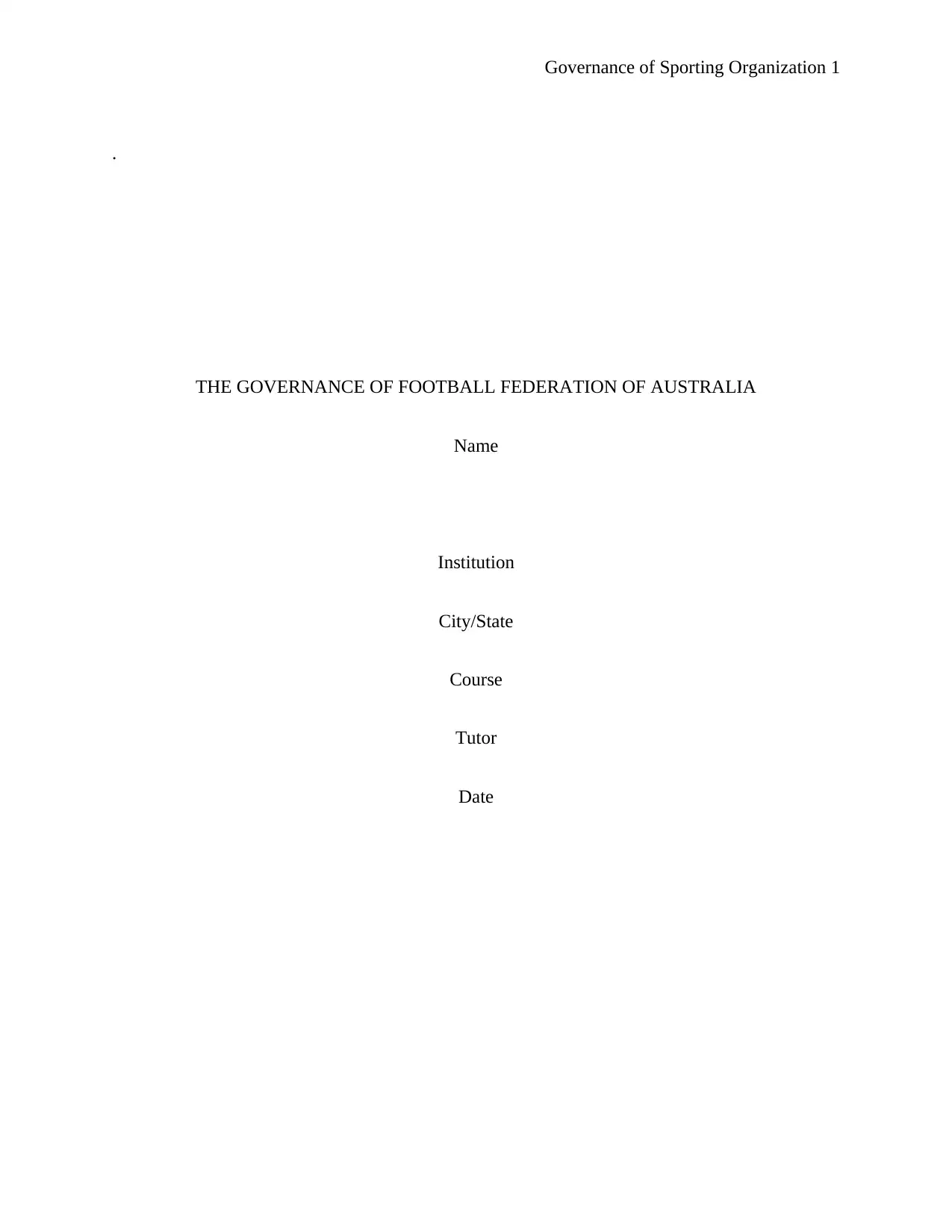
Governance of Sporting Organization 1
.
THE GOVERNANCE OF FOOTBALL FEDERATION OF AUSTRALIA
Name
Institution
City/State
Course
Tutor
Date
.
THE GOVERNANCE OF FOOTBALL FEDERATION OF AUSTRALIA
Name
Institution
City/State
Course
Tutor
Date
Paraphrase This Document
Need a fresh take? Get an instant paraphrase of this document with our AI Paraphraser
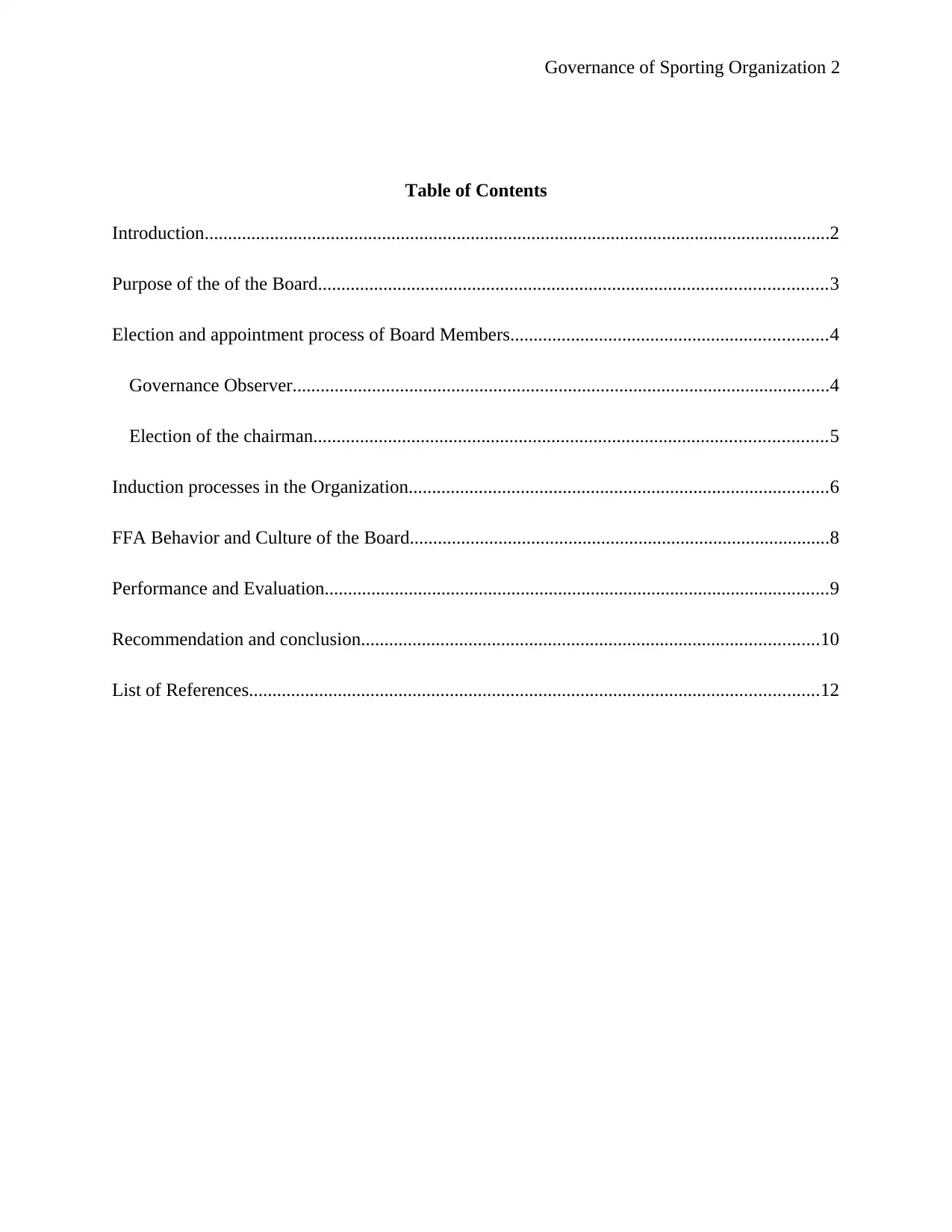
Governance of Sporting Organization 2
Table of Contents
Introduction......................................................................................................................................2
Purpose of the of the Board.............................................................................................................3
Election and appointment process of Board Members....................................................................4
Governance Observer...................................................................................................................4
Election of the chairman..............................................................................................................5
Induction processes in the Organization..........................................................................................6
FFA Behavior and Culture of the Board..........................................................................................8
Performance and Evaluation............................................................................................................9
Recommendation and conclusion..................................................................................................10
List of References..........................................................................................................................12
Table of Contents
Introduction......................................................................................................................................2
Purpose of the of the Board.............................................................................................................3
Election and appointment process of Board Members....................................................................4
Governance Observer...................................................................................................................4
Election of the chairman..............................................................................................................5
Induction processes in the Organization..........................................................................................6
FFA Behavior and Culture of the Board..........................................................................................8
Performance and Evaluation............................................................................................................9
Recommendation and conclusion..................................................................................................10
List of References..........................................................................................................................12
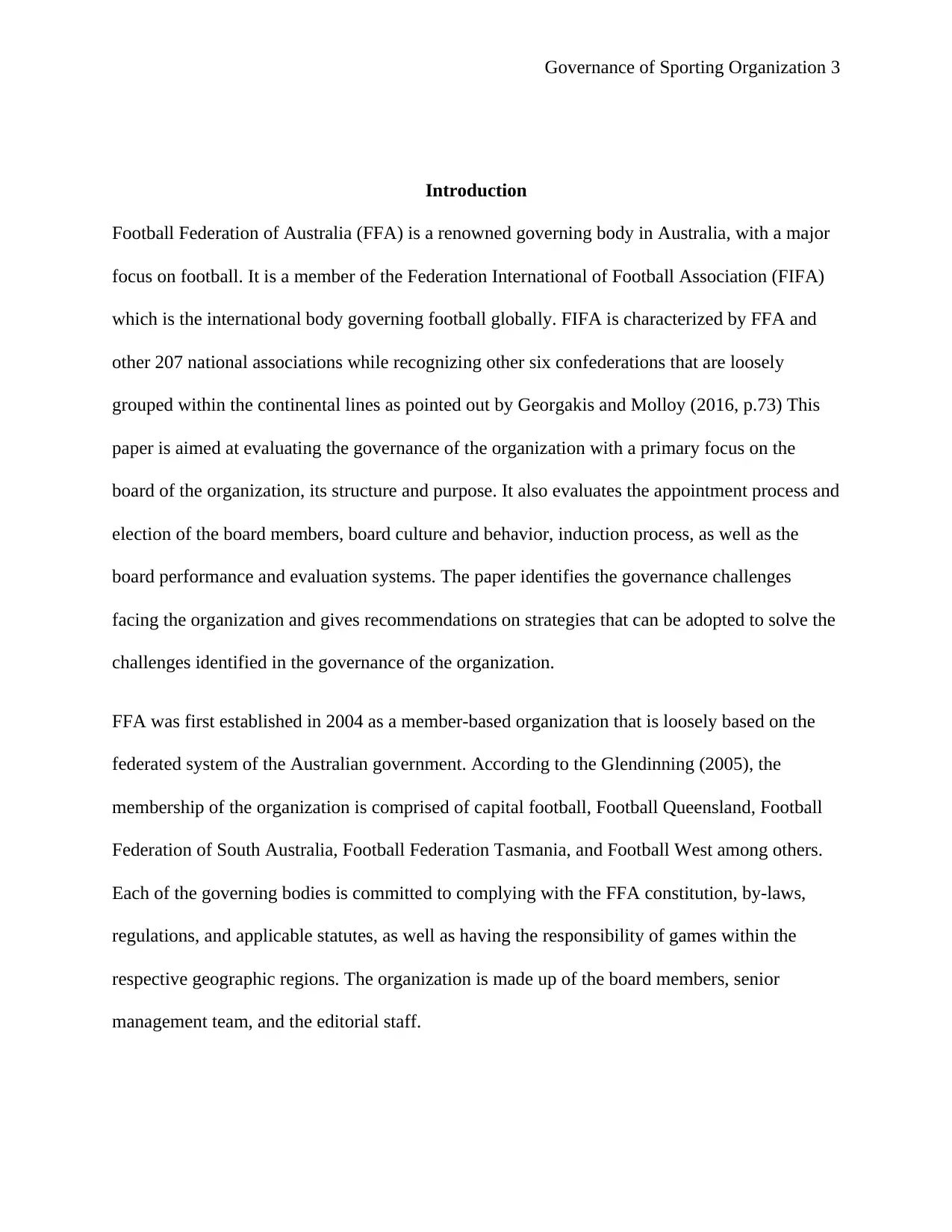
Governance of Sporting Organization 3
Introduction
Football Federation of Australia (FFA) is a renowned governing body in Australia, with a major
focus on football. It is a member of the Federation International of Football Association (FIFA)
which is the international body governing football globally. FIFA is characterized by FFA and
other 207 national associations while recognizing other six confederations that are loosely
grouped within the continental lines as pointed out by Georgakis and Molloy (2016, p.73) This
paper is aimed at evaluating the governance of the organization with a primary focus on the
board of the organization, its structure and purpose. It also evaluates the appointment process and
election of the board members, board culture and behavior, induction process, as well as the
board performance and evaluation systems. The paper identifies the governance challenges
facing the organization and gives recommendations on strategies that can be adopted to solve the
challenges identified in the governance of the organization.
FFA was first established in 2004 as a member-based organization that is loosely based on the
federated system of the Australian government. According to the Glendinning (2005), the
membership of the organization is comprised of capital football, Football Queensland, Football
Federation of South Australia, Football Federation Tasmania, and Football West among others.
Each of the governing bodies is committed to complying with the FFA constitution, by-laws,
regulations, and applicable statutes, as well as having the responsibility of games within the
respective geographic regions. The organization is made up of the board members, senior
management team, and the editorial staff.
Introduction
Football Federation of Australia (FFA) is a renowned governing body in Australia, with a major
focus on football. It is a member of the Federation International of Football Association (FIFA)
which is the international body governing football globally. FIFA is characterized by FFA and
other 207 national associations while recognizing other six confederations that are loosely
grouped within the continental lines as pointed out by Georgakis and Molloy (2016, p.73) This
paper is aimed at evaluating the governance of the organization with a primary focus on the
board of the organization, its structure and purpose. It also evaluates the appointment process and
election of the board members, board culture and behavior, induction process, as well as the
board performance and evaluation systems. The paper identifies the governance challenges
facing the organization and gives recommendations on strategies that can be adopted to solve the
challenges identified in the governance of the organization.
FFA was first established in 2004 as a member-based organization that is loosely based on the
federated system of the Australian government. According to the Glendinning (2005), the
membership of the organization is comprised of capital football, Football Queensland, Football
Federation of South Australia, Football Federation Tasmania, and Football West among others.
Each of the governing bodies is committed to complying with the FFA constitution, by-laws,
regulations, and applicable statutes, as well as having the responsibility of games within the
respective geographic regions. The organization is made up of the board members, senior
management team, and the editorial staff.
⊘ This is a preview!⊘
Do you want full access?
Subscribe today to unlock all pages.

Trusted by 1+ million students worldwide
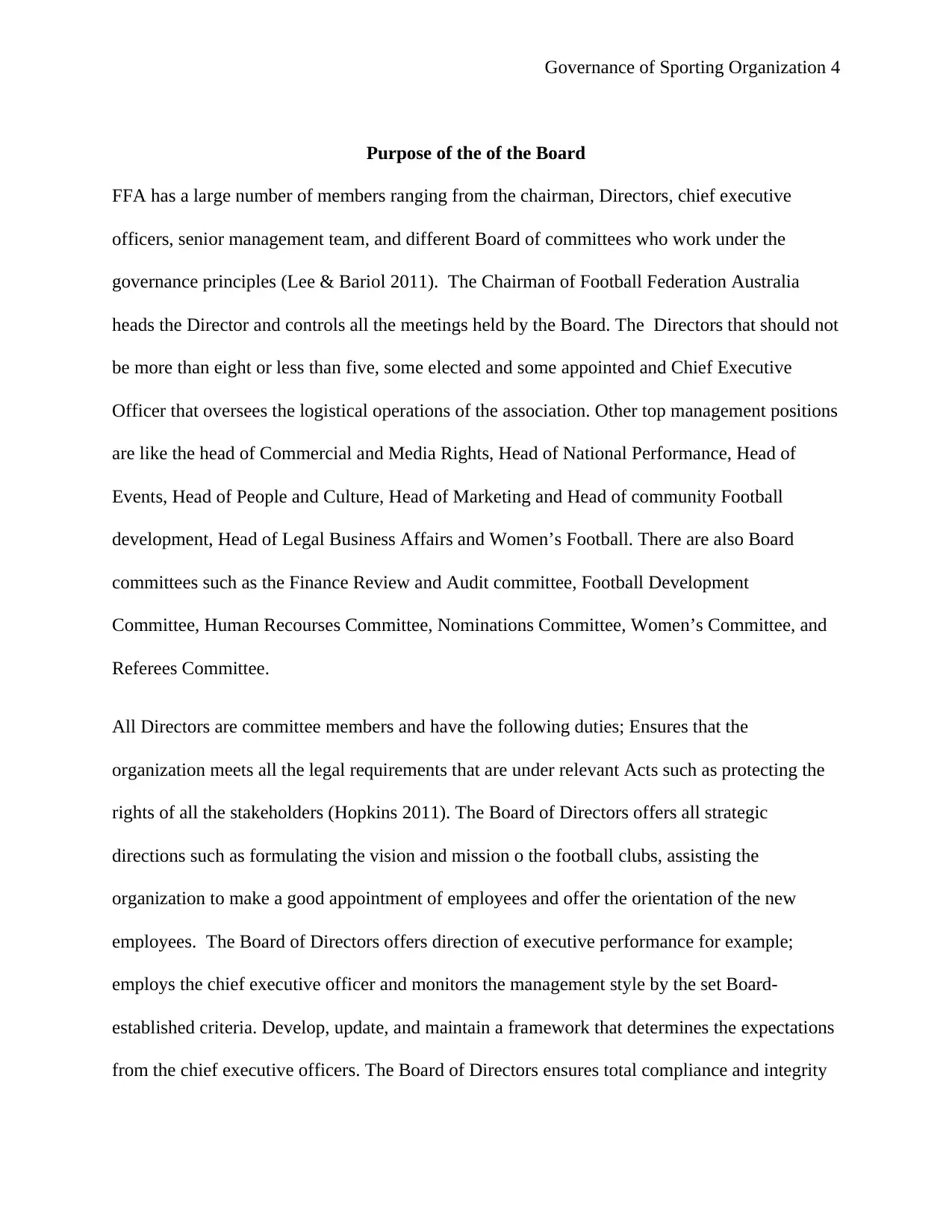
Governance of Sporting Organization 4
Purpose of the of the Board
FFA has a large number of members ranging from the chairman, Directors, chief executive
officers, senior management team, and different Board of committees who work under the
governance principles (Lee & Bariol 2011). The Chairman of Football Federation Australia
heads the Director and controls all the meetings held by the Board. The Directors that should not
be more than eight or less than five, some elected and some appointed and Chief Executive
Officer that oversees the logistical operations of the association. Other top management positions
are like the head of Commercial and Media Rights, Head of National Performance, Head of
Events, Head of People and Culture, Head of Marketing and Head of community Football
development, Head of Legal Business Affairs and Women’s Football. There are also Board
committees such as the Finance Review and Audit committee, Football Development
Committee, Human Recourses Committee, Nominations Committee, Women’s Committee, and
Referees Committee.
All Directors are committee members and have the following duties; Ensures that the
organization meets all the legal requirements that are under relevant Acts such as protecting the
rights of all the stakeholders (Hopkins 2011). The Board of Directors offers all strategic
directions such as formulating the vision and mission o the football clubs, assisting the
organization to make a good appointment of employees and offer the orientation of the new
employees. The Board of Directors offers direction of executive performance for example;
employs the chief executive officer and monitors the management style by the set Board-
established criteria. Develop, update, and maintain a framework that determines the expectations
from the chief executive officers. The Board of Directors ensures total compliance and integrity
Purpose of the of the Board
FFA has a large number of members ranging from the chairman, Directors, chief executive
officers, senior management team, and different Board of committees who work under the
governance principles (Lee & Bariol 2011). The Chairman of Football Federation Australia
heads the Director and controls all the meetings held by the Board. The Directors that should not
be more than eight or less than five, some elected and some appointed and Chief Executive
Officer that oversees the logistical operations of the association. Other top management positions
are like the head of Commercial and Media Rights, Head of National Performance, Head of
Events, Head of People and Culture, Head of Marketing and Head of community Football
development, Head of Legal Business Affairs and Women’s Football. There are also Board
committees such as the Finance Review and Audit committee, Football Development
Committee, Human Recourses Committee, Nominations Committee, Women’s Committee, and
Referees Committee.
All Directors are committee members and have the following duties; Ensures that the
organization meets all the legal requirements that are under relevant Acts such as protecting the
rights of all the stakeholders (Hopkins 2011). The Board of Directors offers all strategic
directions such as formulating the vision and mission o the football clubs, assisting the
organization to make a good appointment of employees and offer the orientation of the new
employees. The Board of Directors offers direction of executive performance for example;
employs the chief executive officer and monitors the management style by the set Board-
established criteria. Develop, update, and maintain a framework that determines the expectations
from the chief executive officers. The Board of Directors ensures total compliance and integrity
Paraphrase This Document
Need a fresh take? Get an instant paraphrase of this document with our AI Paraphraser
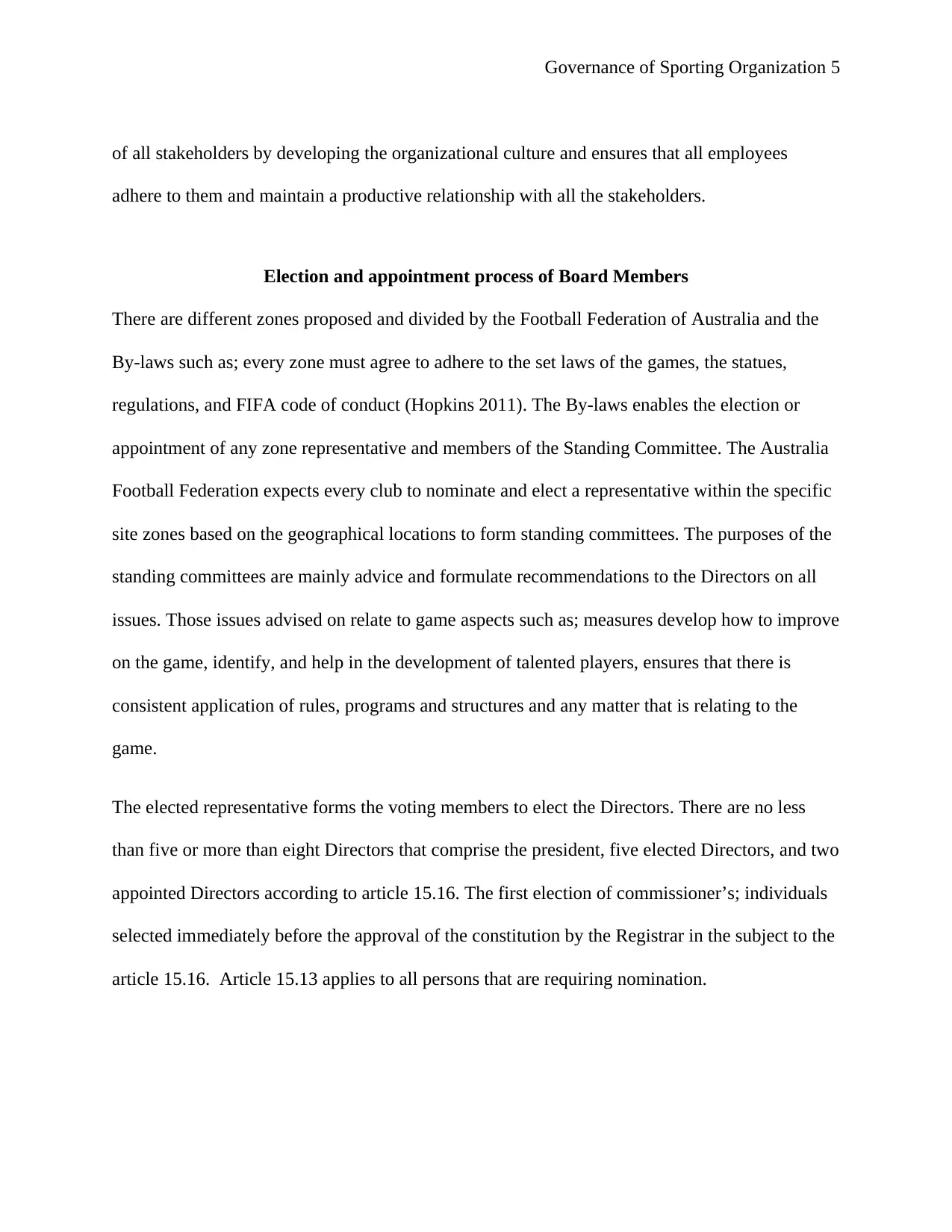
Governance of Sporting Organization 5
of all stakeholders by developing the organizational culture and ensures that all employees
adhere to them and maintain a productive relationship with all the stakeholders.
Election and appointment process of Board Members
There are different zones proposed and divided by the Football Federation of Australia and the
By-laws such as; every zone must agree to adhere to the set laws of the games, the statues,
regulations, and FIFA code of conduct (Hopkins 2011). The By-laws enables the election or
appointment of any zone representative and members of the Standing Committee. The Australia
Football Federation expects every club to nominate and elect a representative within the specific
site zones based on the geographical locations to form standing committees. The purposes of the
standing committees are mainly advice and formulate recommendations to the Directors on all
issues. Those issues advised on relate to game aspects such as; measures develop how to improve
on the game, identify, and help in the development of talented players, ensures that there is
consistent application of rules, programs and structures and any matter that is relating to the
game.
The elected representative forms the voting members to elect the Directors. There are no less
than five or more than eight Directors that comprise the president, five elected Directors, and two
appointed Directors according to article 15.16. The first election of commissioner’s; individuals
selected immediately before the approval of the constitution by the Registrar in the subject to the
article 15.16. Article 15.13 applies to all persons that are requiring nomination.
of all stakeholders by developing the organizational culture and ensures that all employees
adhere to them and maintain a productive relationship with all the stakeholders.
Election and appointment process of Board Members
There are different zones proposed and divided by the Football Federation of Australia and the
By-laws such as; every zone must agree to adhere to the set laws of the games, the statues,
regulations, and FIFA code of conduct (Hopkins 2011). The By-laws enables the election or
appointment of any zone representative and members of the Standing Committee. The Australia
Football Federation expects every club to nominate and elect a representative within the specific
site zones based on the geographical locations to form standing committees. The purposes of the
standing committees are mainly advice and formulate recommendations to the Directors on all
issues. Those issues advised on relate to game aspects such as; measures develop how to improve
on the game, identify, and help in the development of talented players, ensures that there is
consistent application of rules, programs and structures and any matter that is relating to the
game.
The elected representative forms the voting members to elect the Directors. There are no less
than five or more than eight Directors that comprise the president, five elected Directors, and two
appointed Directors according to article 15.16. The first election of commissioner’s; individuals
selected immediately before the approval of the constitution by the Registrar in the subject to the
article 15.16. Article 15.13 applies to all persons that are requiring nomination.
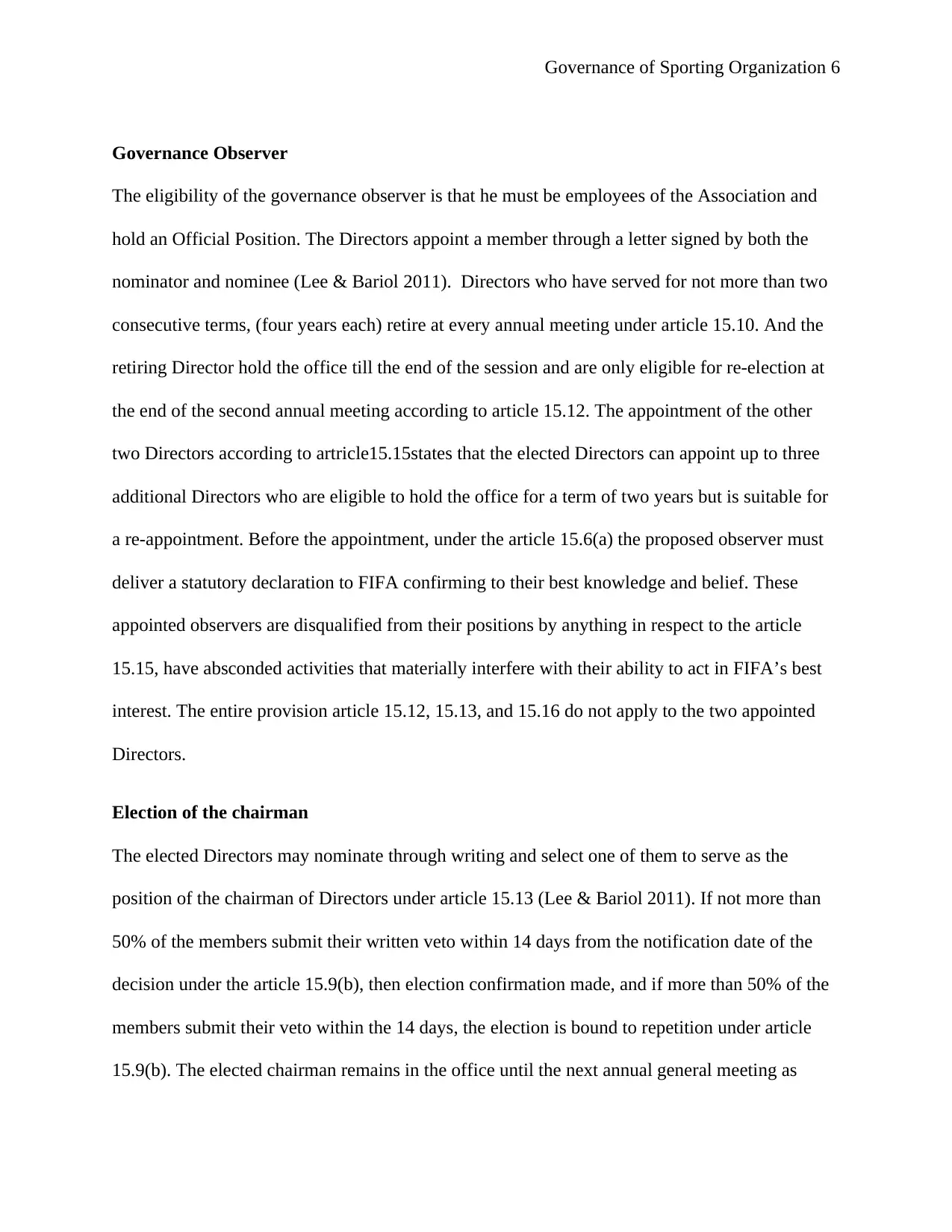
Governance of Sporting Organization 6
Governance Observer
The eligibility of the governance observer is that he must be employees of the Association and
hold an Official Position. The Directors appoint a member through a letter signed by both the
nominator and nominee (Lee & Bariol 2011). Directors who have served for not more than two
consecutive terms, (four years each) retire at every annual meeting under article 15.10. And the
retiring Director hold the office till the end of the session and are only eligible for re-election at
the end of the second annual meeting according to article 15.12. The appointment of the other
two Directors according to artricle15.15states that the elected Directors can appoint up to three
additional Directors who are eligible to hold the office for a term of two years but is suitable for
a re-appointment. Before the appointment, under the article 15.6(a) the proposed observer must
deliver a statutory declaration to FIFA confirming to their best knowledge and belief. These
appointed observers are disqualified from their positions by anything in respect to the article
15.15, have absconded activities that materially interfere with their ability to act in FIFA’s best
interest. The entire provision article 15.12, 15.13, and 15.16 do not apply to the two appointed
Directors.
Election of the chairman
The elected Directors may nominate through writing and select one of them to serve as the
position of the chairman of Directors under article 15.13 (Lee & Bariol 2011). If not more than
50% of the members submit their written veto within 14 days from the notification date of the
decision under the article 15.9(b), then election confirmation made, and if more than 50% of the
members submit their veto within the 14 days, the election is bound to repetition under article
15.9(b). The elected chairman remains in the office until the next annual general meeting as
Governance Observer
The eligibility of the governance observer is that he must be employees of the Association and
hold an Official Position. The Directors appoint a member through a letter signed by both the
nominator and nominee (Lee & Bariol 2011). Directors who have served for not more than two
consecutive terms, (four years each) retire at every annual meeting under article 15.10. And the
retiring Director hold the office till the end of the session and are only eligible for re-election at
the end of the second annual meeting according to article 15.12. The appointment of the other
two Directors according to artricle15.15states that the elected Directors can appoint up to three
additional Directors who are eligible to hold the office for a term of two years but is suitable for
a re-appointment. Before the appointment, under the article 15.6(a) the proposed observer must
deliver a statutory declaration to FIFA confirming to their best knowledge and belief. These
appointed observers are disqualified from their positions by anything in respect to the article
15.15, have absconded activities that materially interfere with their ability to act in FIFA’s best
interest. The entire provision article 15.12, 15.13, and 15.16 do not apply to the two appointed
Directors.
Election of the chairman
The elected Directors may nominate through writing and select one of them to serve as the
position of the chairman of Directors under article 15.13 (Lee & Bariol 2011). If not more than
50% of the members submit their written veto within 14 days from the notification date of the
decision under the article 15.9(b), then election confirmation made, and if more than 50% of the
members submit their veto within the 14 days, the election is bound to repetition under article
15.9(b). The elected chairman remains in the office until the next annual general meeting as
⊘ This is a preview!⊘
Do you want full access?
Subscribe today to unlock all pages.

Trusted by 1+ million students worldwide
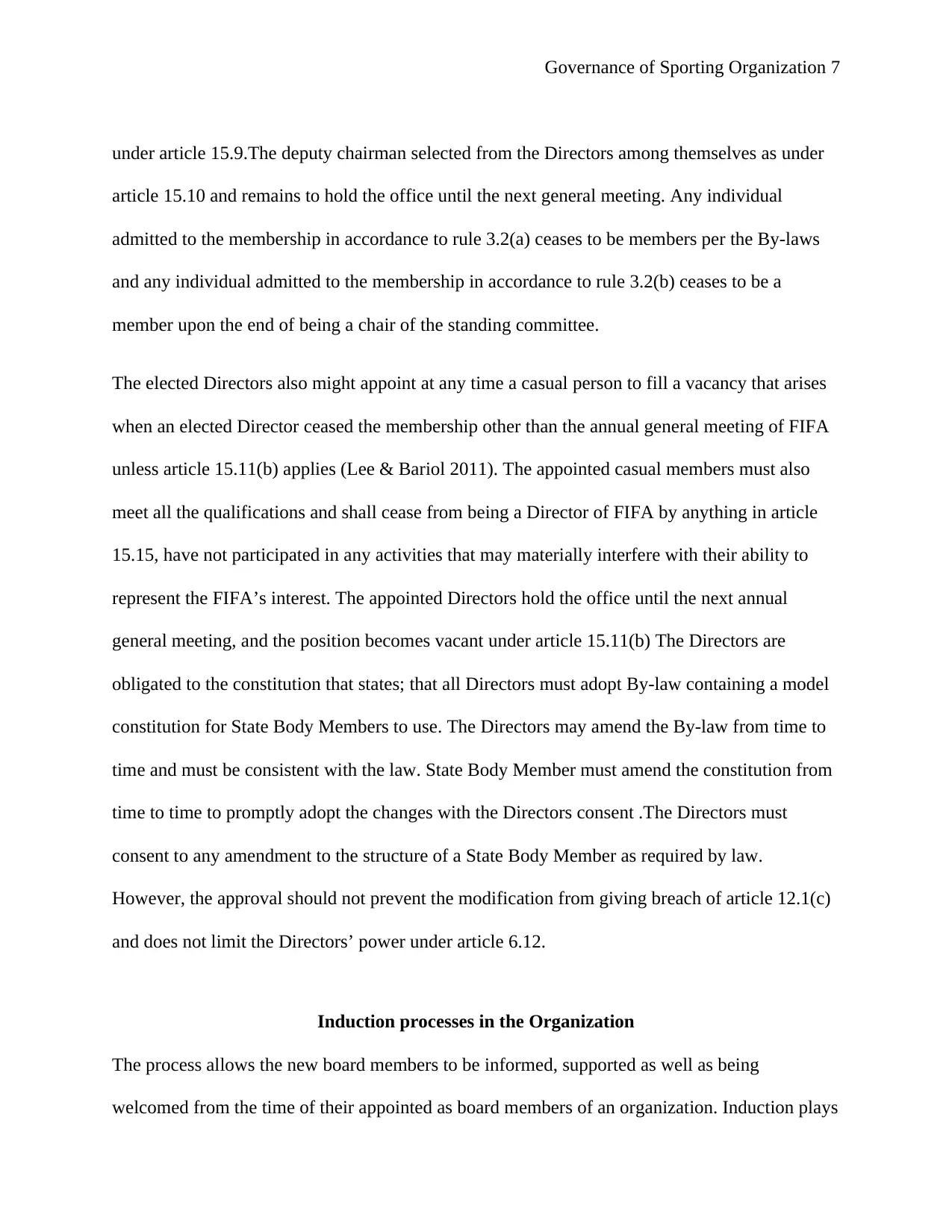
Governance of Sporting Organization 7
under article 15.9.The deputy chairman selected from the Directors among themselves as under
article 15.10 and remains to hold the office until the next general meeting. Any individual
admitted to the membership in accordance to rule 3.2(a) ceases to be members per the By-laws
and any individual admitted to the membership in accordance to rule 3.2(b) ceases to be a
member upon the end of being a chair of the standing committee.
The elected Directors also might appoint at any time a casual person to fill a vacancy that arises
when an elected Director ceased the membership other than the annual general meeting of FIFA
unless article 15.11(b) applies (Lee & Bariol 2011). The appointed casual members must also
meet all the qualifications and shall cease from being a Director of FIFA by anything in article
15.15, have not participated in any activities that may materially interfere with their ability to
represent the FIFA’s interest. The appointed Directors hold the office until the next annual
general meeting, and the position becomes vacant under article 15.11(b) The Directors are
obligated to the constitution that states; that all Directors must adopt By-law containing a model
constitution for State Body Members to use. The Directors may amend the By-law from time to
time and must be consistent with the law. State Body Member must amend the constitution from
time to time to promptly adopt the changes with the Directors consent .The Directors must
consent to any amendment to the structure of a State Body Member as required by law.
However, the approval should not prevent the modification from giving breach of article 12.1(c)
and does not limit the Directors’ power under article 6.12.
Induction processes in the Organization
The process allows the new board members to be informed, supported as well as being
welcomed from the time of their appointed as board members of an organization. Induction plays
under article 15.9.The deputy chairman selected from the Directors among themselves as under
article 15.10 and remains to hold the office until the next general meeting. Any individual
admitted to the membership in accordance to rule 3.2(a) ceases to be members per the By-laws
and any individual admitted to the membership in accordance to rule 3.2(b) ceases to be a
member upon the end of being a chair of the standing committee.
The elected Directors also might appoint at any time a casual person to fill a vacancy that arises
when an elected Director ceased the membership other than the annual general meeting of FIFA
unless article 15.11(b) applies (Lee & Bariol 2011). The appointed casual members must also
meet all the qualifications and shall cease from being a Director of FIFA by anything in article
15.15, have not participated in any activities that may materially interfere with their ability to
represent the FIFA’s interest. The appointed Directors hold the office until the next annual
general meeting, and the position becomes vacant under article 15.11(b) The Directors are
obligated to the constitution that states; that all Directors must adopt By-law containing a model
constitution for State Body Members to use. The Directors may amend the By-law from time to
time and must be consistent with the law. State Body Member must amend the constitution from
time to time to promptly adopt the changes with the Directors consent .The Directors must
consent to any amendment to the structure of a State Body Member as required by law.
However, the approval should not prevent the modification from giving breach of article 12.1(c)
and does not limit the Directors’ power under article 6.12.
Induction processes in the Organization
The process allows the new board members to be informed, supported as well as being
welcomed from the time of their appointed as board members of an organization. Induction plays
Paraphrase This Document
Need a fresh take? Get an instant paraphrase of this document with our AI Paraphraser
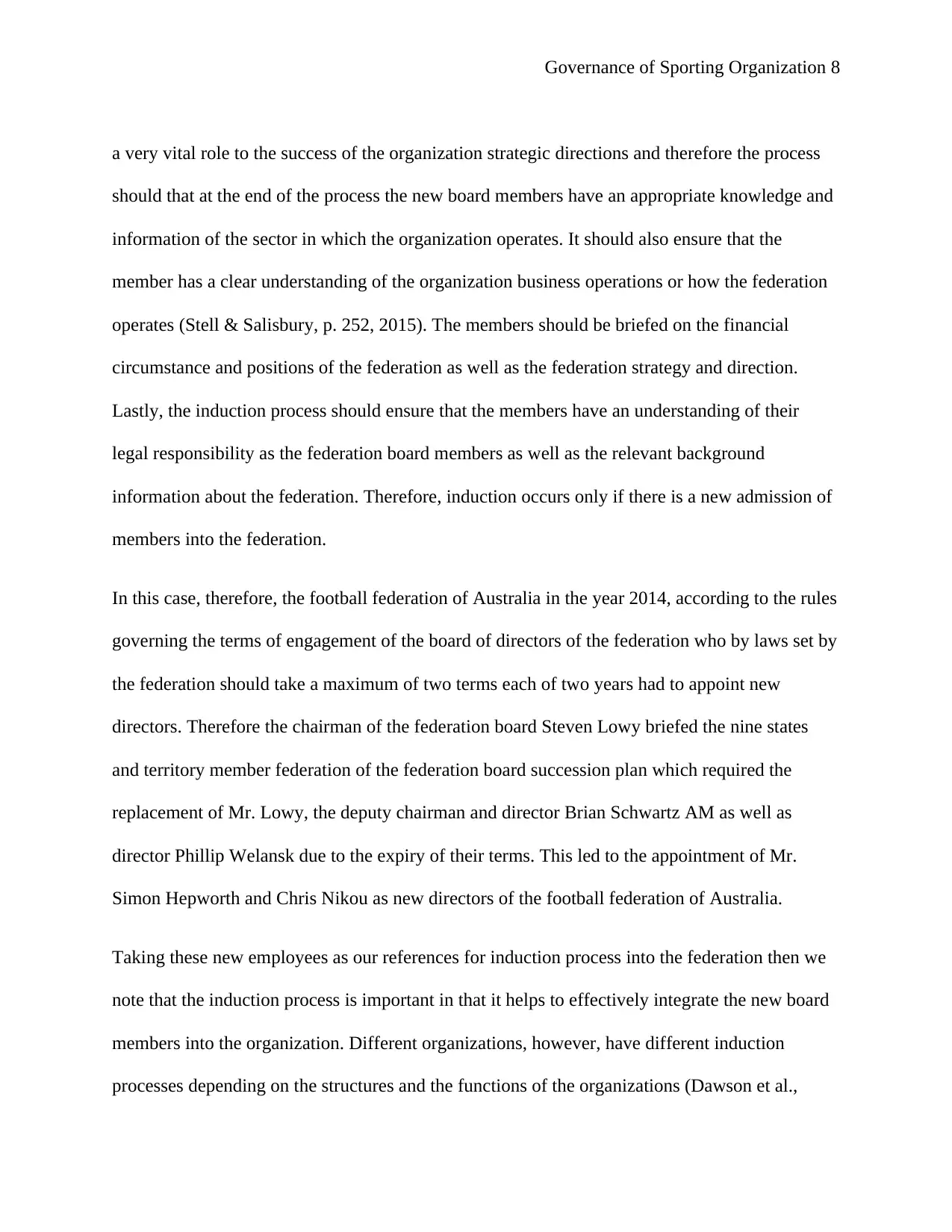
Governance of Sporting Organization 8
a very vital role to the success of the organization strategic directions and therefore the process
should that at the end of the process the new board members have an appropriate knowledge and
information of the sector in which the organization operates. It should also ensure that the
member has a clear understanding of the organization business operations or how the federation
operates (Stell & Salisbury, p. 252, 2015). The members should be briefed on the financial
circumstance and positions of the federation as well as the federation strategy and direction.
Lastly, the induction process should ensure that the members have an understanding of their
legal responsibility as the federation board members as well as the relevant background
information about the federation. Therefore, induction occurs only if there is a new admission of
members into the federation.
In this case, therefore, the football federation of Australia in the year 2014, according to the rules
governing the terms of engagement of the board of directors of the federation who by laws set by
the federation should take a maximum of two terms each of two years had to appoint new
directors. Therefore the chairman of the federation board Steven Lowy briefed the nine states
and territory member federation of the federation board succession plan which required the
replacement of Mr. Lowy, the deputy chairman and director Brian Schwartz AM as well as
director Phillip Welansk due to the expiry of their terms. This led to the appointment of Mr.
Simon Hepworth and Chris Nikou as new directors of the football federation of Australia.
Taking these new employees as our references for induction process into the federation then we
note that the induction process is important in that it helps to effectively integrate the new board
members into the organization. Different organizations, however, have different induction
processes depending on the structures and the functions of the organizations (Dawson et al.,
a very vital role to the success of the organization strategic directions and therefore the process
should that at the end of the process the new board members have an appropriate knowledge and
information of the sector in which the organization operates. It should also ensure that the
member has a clear understanding of the organization business operations or how the federation
operates (Stell & Salisbury, p. 252, 2015). The members should be briefed on the financial
circumstance and positions of the federation as well as the federation strategy and direction.
Lastly, the induction process should ensure that the members have an understanding of their
legal responsibility as the federation board members as well as the relevant background
information about the federation. Therefore, induction occurs only if there is a new admission of
members into the federation.
In this case, therefore, the football federation of Australia in the year 2014, according to the rules
governing the terms of engagement of the board of directors of the federation who by laws set by
the federation should take a maximum of two terms each of two years had to appoint new
directors. Therefore the chairman of the federation board Steven Lowy briefed the nine states
and territory member federation of the federation board succession plan which required the
replacement of Mr. Lowy, the deputy chairman and director Brian Schwartz AM as well as
director Phillip Welansk due to the expiry of their terms. This led to the appointment of Mr.
Simon Hepworth and Chris Nikou as new directors of the football federation of Australia.
Taking these new employees as our references for induction process into the federation then we
note that the induction process is important in that it helps to effectively integrate the new board
members into the organization. Different organizations, however, have different induction
processes depending on the structures and the functions of the organizations (Dawson et al.,
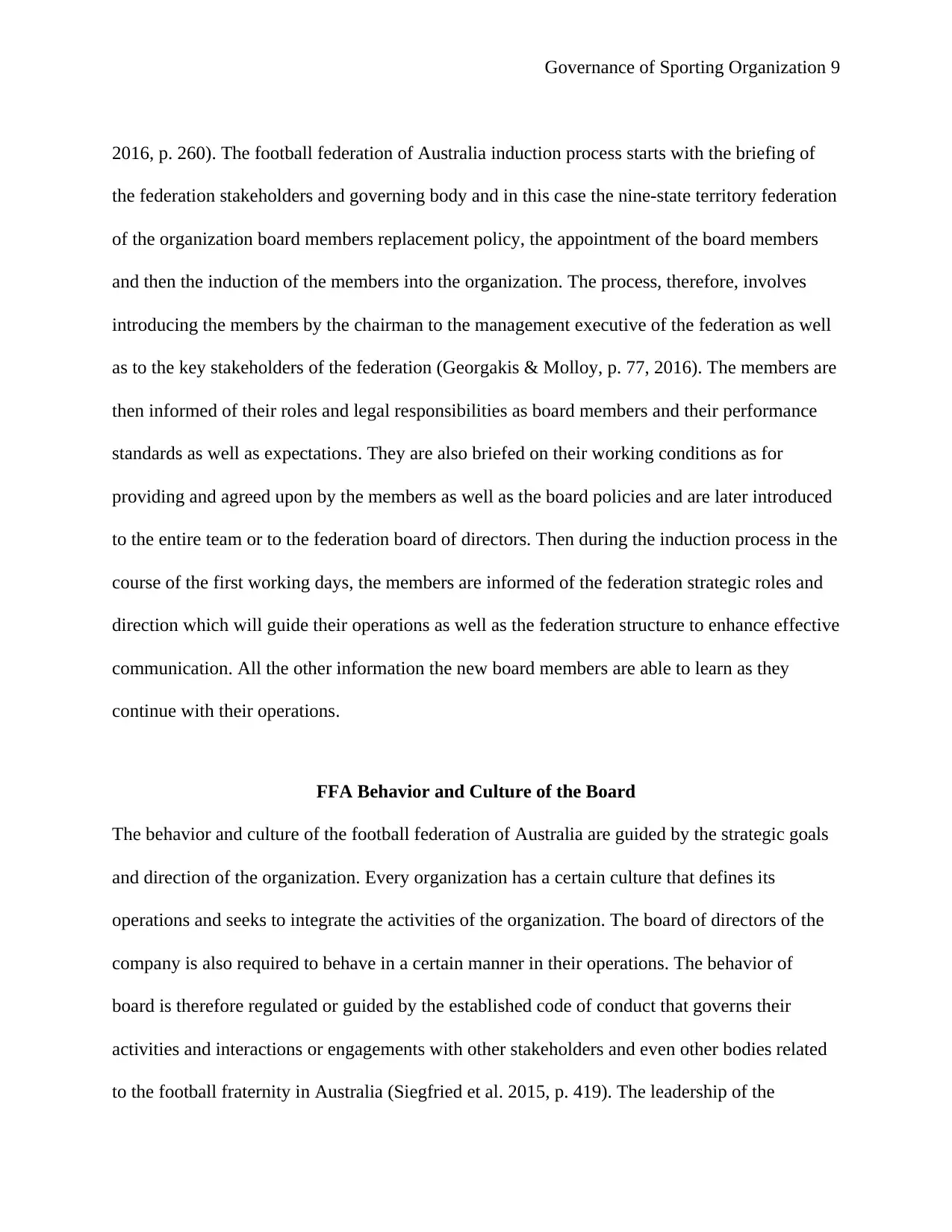
Governance of Sporting Organization 9
2016, p. 260). The football federation of Australia induction process starts with the briefing of
the federation stakeholders and governing body and in this case the nine-state territory federation
of the organization board members replacement policy, the appointment of the board members
and then the induction of the members into the organization. The process, therefore, involves
introducing the members by the chairman to the management executive of the federation as well
as to the key stakeholders of the federation (Georgakis & Molloy, p. 77, 2016). The members are
then informed of their roles and legal responsibilities as board members and their performance
standards as well as expectations. They are also briefed on their working conditions as for
providing and agreed upon by the members as well as the board policies and are later introduced
to the entire team or to the federation board of directors. Then during the induction process in the
course of the first working days, the members are informed of the federation strategic roles and
direction which will guide their operations as well as the federation structure to enhance effective
communication. All the other information the new board members are able to learn as they
continue with their operations.
FFA Behavior and Culture of the Board
The behavior and culture of the football federation of Australia are guided by the strategic goals
and direction of the organization. Every organization has a certain culture that defines its
operations and seeks to integrate the activities of the organization. The board of directors of the
company is also required to behave in a certain manner in their operations. The behavior of
board is therefore regulated or guided by the established code of conduct that governs their
activities and interactions or engagements with other stakeholders and even other bodies related
to the football fraternity in Australia (Siegfried et al. 2015, p. 419). The leadership of the
2016, p. 260). The football federation of Australia induction process starts with the briefing of
the federation stakeholders and governing body and in this case the nine-state territory federation
of the organization board members replacement policy, the appointment of the board members
and then the induction of the members into the organization. The process, therefore, involves
introducing the members by the chairman to the management executive of the federation as well
as to the key stakeholders of the federation (Georgakis & Molloy, p. 77, 2016). The members are
then informed of their roles and legal responsibilities as board members and their performance
standards as well as expectations. They are also briefed on their working conditions as for
providing and agreed upon by the members as well as the board policies and are later introduced
to the entire team or to the federation board of directors. Then during the induction process in the
course of the first working days, the members are informed of the federation strategic roles and
direction which will guide their operations as well as the federation structure to enhance effective
communication. All the other information the new board members are able to learn as they
continue with their operations.
FFA Behavior and Culture of the Board
The behavior and culture of the football federation of Australia are guided by the strategic goals
and direction of the organization. Every organization has a certain culture that defines its
operations and seeks to integrate the activities of the organization. The board of directors of the
company is also required to behave in a certain manner in their operations. The behavior of
board is therefore regulated or guided by the established code of conduct that governs their
activities and interactions or engagements with other stakeholders and even other bodies related
to the football fraternity in Australia (Siegfried et al. 2015, p. 419). The leadership of the
⊘ This is a preview!⊘
Do you want full access?
Subscribe today to unlock all pages.

Trusted by 1+ million students worldwide
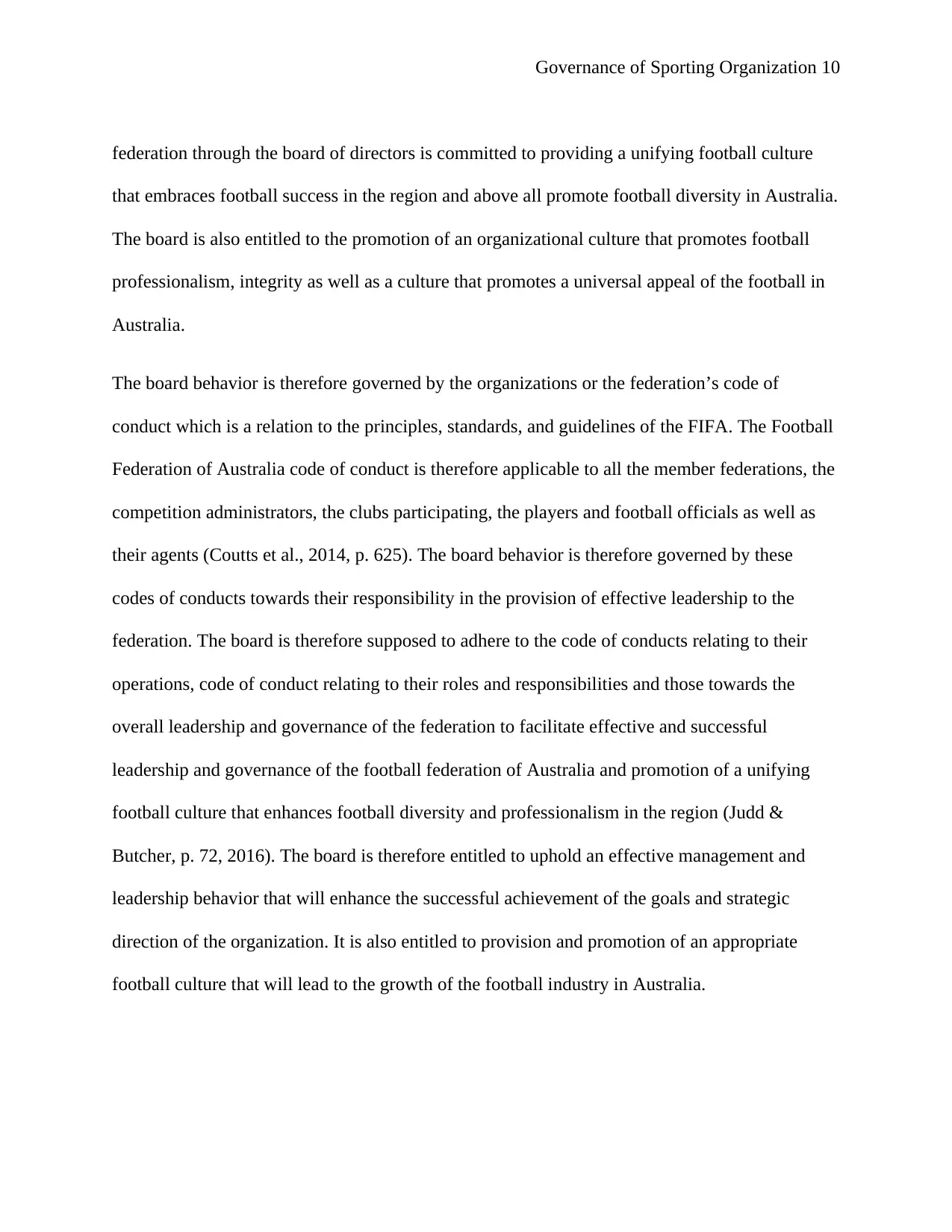
Governance of Sporting Organization 10
federation through the board of directors is committed to providing a unifying football culture
that embraces football success in the region and above all promote football diversity in Australia.
The board is also entitled to the promotion of an organizational culture that promotes football
professionalism, integrity as well as a culture that promotes a universal appeal of the football in
Australia.
The board behavior is therefore governed by the organizations or the federation’s code of
conduct which is a relation to the principles, standards, and guidelines of the FIFA. The Football
Federation of Australia code of conduct is therefore applicable to all the member federations, the
competition administrators, the clubs participating, the players and football officials as well as
their agents (Coutts et al., 2014, p. 625). The board behavior is therefore governed by these
codes of conducts towards their responsibility in the provision of effective leadership to the
federation. The board is therefore supposed to adhere to the code of conducts relating to their
operations, code of conduct relating to their roles and responsibilities and those towards the
overall leadership and governance of the federation to facilitate effective and successful
leadership and governance of the football federation of Australia and promotion of a unifying
football culture that enhances football diversity and professionalism in the region (Judd &
Butcher, p. 72, 2016). The board is therefore entitled to uphold an effective management and
leadership behavior that will enhance the successful achievement of the goals and strategic
direction of the organization. It is also entitled to provision and promotion of an appropriate
football culture that will lead to the growth of the football industry in Australia.
federation through the board of directors is committed to providing a unifying football culture
that embraces football success in the region and above all promote football diversity in Australia.
The board is also entitled to the promotion of an organizational culture that promotes football
professionalism, integrity as well as a culture that promotes a universal appeal of the football in
Australia.
The board behavior is therefore governed by the organizations or the federation’s code of
conduct which is a relation to the principles, standards, and guidelines of the FIFA. The Football
Federation of Australia code of conduct is therefore applicable to all the member federations, the
competition administrators, the clubs participating, the players and football officials as well as
their agents (Coutts et al., 2014, p. 625). The board behavior is therefore governed by these
codes of conducts towards their responsibility in the provision of effective leadership to the
federation. The board is therefore supposed to adhere to the code of conducts relating to their
operations, code of conduct relating to their roles and responsibilities and those towards the
overall leadership and governance of the federation to facilitate effective and successful
leadership and governance of the football federation of Australia and promotion of a unifying
football culture that enhances football diversity and professionalism in the region (Judd &
Butcher, p. 72, 2016). The board is therefore entitled to uphold an effective management and
leadership behavior that will enhance the successful achievement of the goals and strategic
direction of the organization. It is also entitled to provision and promotion of an appropriate
football culture that will lead to the growth of the football industry in Australia.
Paraphrase This Document
Need a fresh take? Get an instant paraphrase of this document with our AI Paraphraser
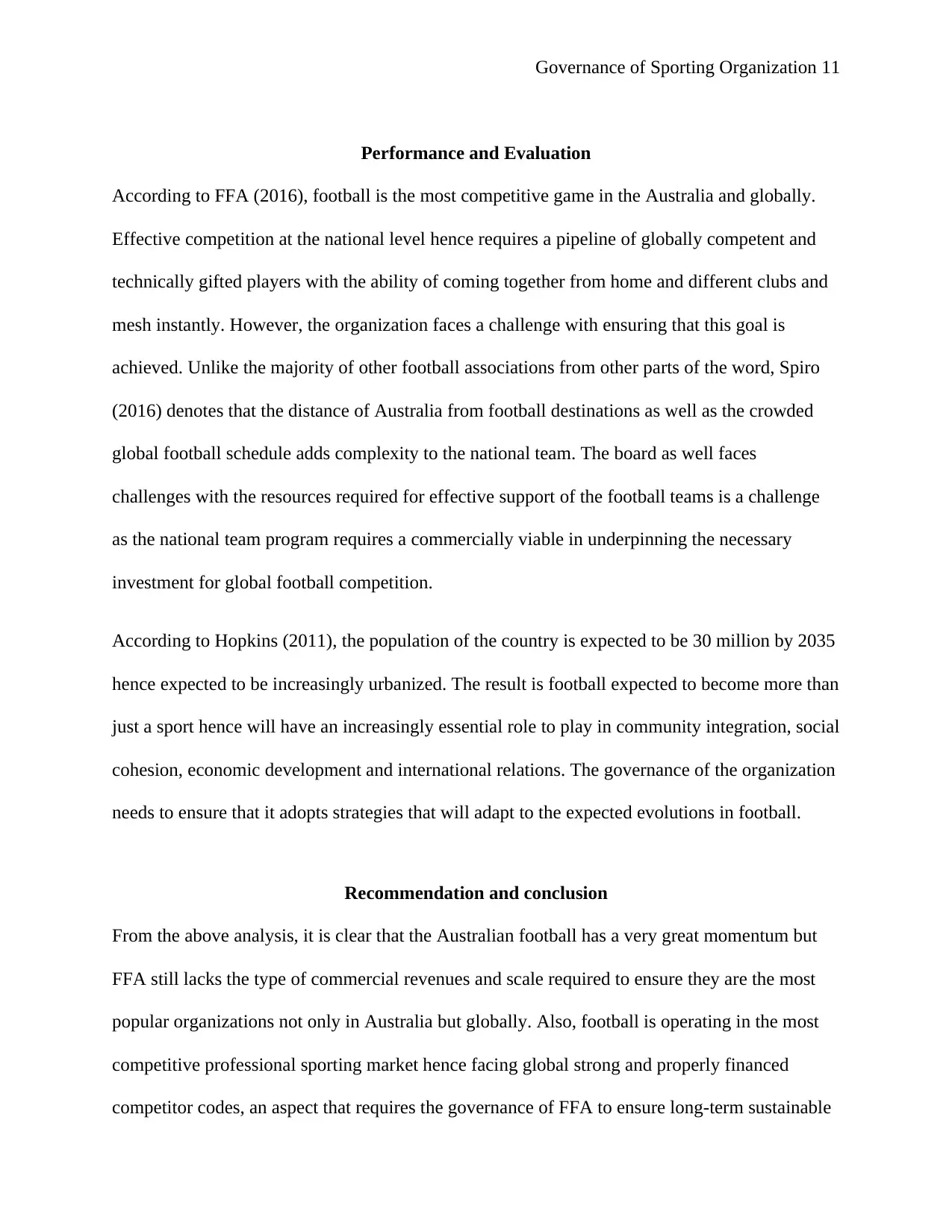
Governance of Sporting Organization 11
Performance and Evaluation
According to FFA (2016), football is the most competitive game in the Australia and globally.
Effective competition at the national level hence requires a pipeline of globally competent and
technically gifted players with the ability of coming together from home and different clubs and
mesh instantly. However, the organization faces a challenge with ensuring that this goal is
achieved. Unlike the majority of other football associations from other parts of the word, Spiro
(2016) denotes that the distance of Australia from football destinations as well as the crowded
global football schedule adds complexity to the national team. The board as well faces
challenges with the resources required for effective support of the football teams is a challenge
as the national team program requires a commercially viable in underpinning the necessary
investment for global football competition.
According to Hopkins (2011), the population of the country is expected to be 30 million by 2035
hence expected to be increasingly urbanized. The result is football expected to become more than
just a sport hence will have an increasingly essential role to play in community integration, social
cohesion, economic development and international relations. The governance of the organization
needs to ensure that it adopts strategies that will adapt to the expected evolutions in football.
Recommendation and conclusion
From the above analysis, it is clear that the Australian football has a very great momentum but
FFA still lacks the type of commercial revenues and scale required to ensure they are the most
popular organizations not only in Australia but globally. Also, football is operating in the most
competitive professional sporting market hence facing global strong and properly financed
competitor codes, an aspect that requires the governance of FFA to ensure long-term sustainable
Performance and Evaluation
According to FFA (2016), football is the most competitive game in the Australia and globally.
Effective competition at the national level hence requires a pipeline of globally competent and
technically gifted players with the ability of coming together from home and different clubs and
mesh instantly. However, the organization faces a challenge with ensuring that this goal is
achieved. Unlike the majority of other football associations from other parts of the word, Spiro
(2016) denotes that the distance of Australia from football destinations as well as the crowded
global football schedule adds complexity to the national team. The board as well faces
challenges with the resources required for effective support of the football teams is a challenge
as the national team program requires a commercially viable in underpinning the necessary
investment for global football competition.
According to Hopkins (2011), the population of the country is expected to be 30 million by 2035
hence expected to be increasingly urbanized. The result is football expected to become more than
just a sport hence will have an increasingly essential role to play in community integration, social
cohesion, economic development and international relations. The governance of the organization
needs to ensure that it adopts strategies that will adapt to the expected evolutions in football.
Recommendation and conclusion
From the above analysis, it is clear that the Australian football has a very great momentum but
FFA still lacks the type of commercial revenues and scale required to ensure they are the most
popular organizations not only in Australia but globally. Also, football is operating in the most
competitive professional sporting market hence facing global strong and properly financed
competitor codes, an aspect that requires the governance of FFA to ensure long-term sustainable
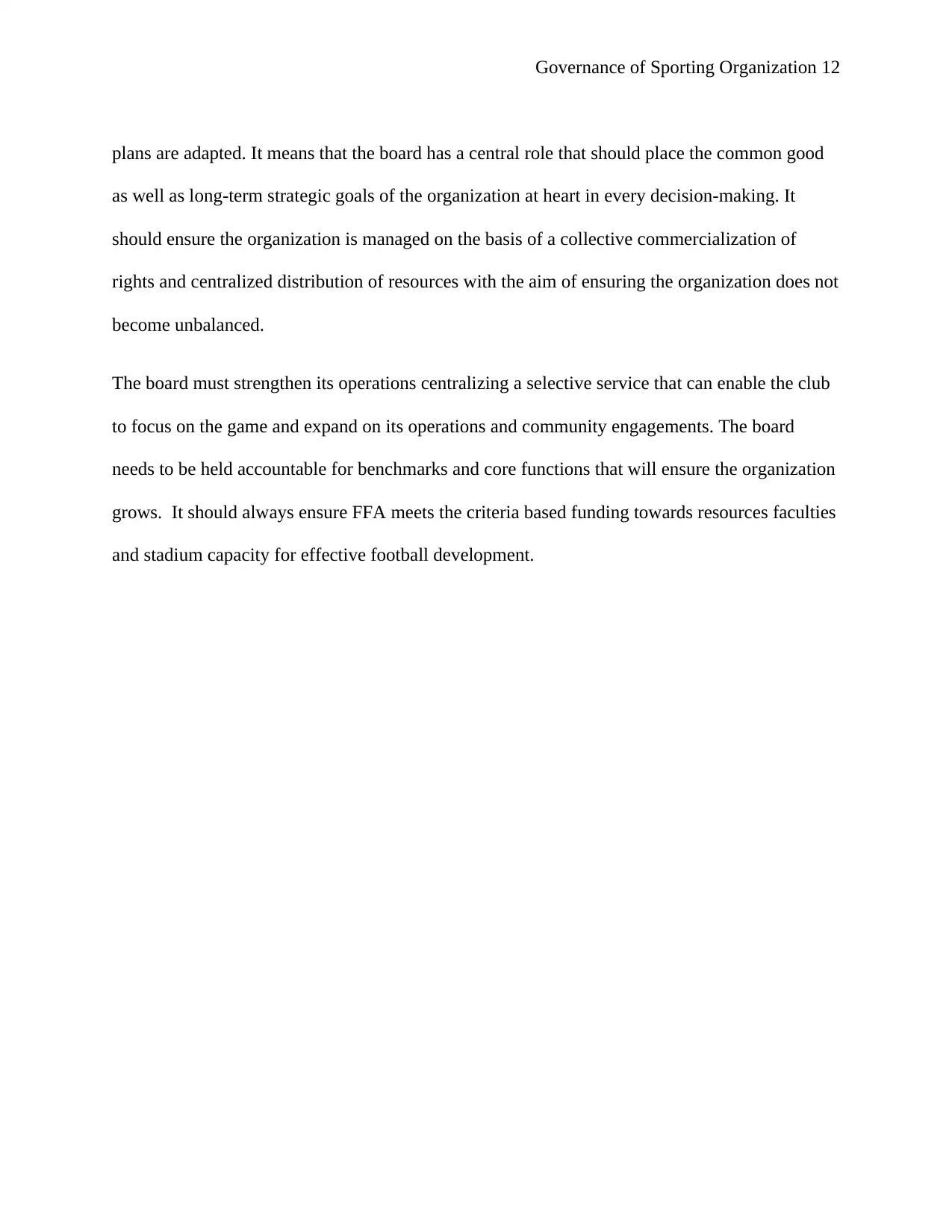
Governance of Sporting Organization 12
plans are adapted. It means that the board has a central role that should place the common good
as well as long-term strategic goals of the organization at heart in every decision-making. It
should ensure the organization is managed on the basis of a collective commercialization of
rights and centralized distribution of resources with the aim of ensuring the organization does not
become unbalanced.
The board must strengthen its operations centralizing a selective service that can enable the club
to focus on the game and expand on its operations and community engagements. The board
needs to be held accountable for benchmarks and core functions that will ensure the organization
grows. It should always ensure FFA meets the criteria based funding towards resources faculties
and stadium capacity for effective football development.
plans are adapted. It means that the board has a central role that should place the common good
as well as long-term strategic goals of the organization at heart in every decision-making. It
should ensure the organization is managed on the basis of a collective commercialization of
rights and centralized distribution of resources with the aim of ensuring the organization does not
become unbalanced.
The board must strengthen its operations centralizing a selective service that can enable the club
to focus on the game and expand on its operations and community engagements. The board
needs to be held accountable for benchmarks and core functions that will ensure the organization
grows. It should always ensure FFA meets the criteria based funding towards resources faculties
and stadium capacity for effective football development.
⊘ This is a preview!⊘
Do you want full access?
Subscribe today to unlock all pages.

Trusted by 1+ million students worldwide
1 out of 15
Related Documents
Your All-in-One AI-Powered Toolkit for Academic Success.
+13062052269
info@desklib.com
Available 24*7 on WhatsApp / Email
![[object Object]](/_next/static/media/star-bottom.7253800d.svg)
Unlock your academic potential
Copyright © 2020–2025 A2Z Services. All Rights Reserved. Developed and managed by ZUCOL.



![SPORTS GOVERNANCE AND STRATEGY: Report for [University Name]](/_next/image/?url=https%3A%2F%2Fdesklib.com%2Fmedia%2Fimages%2Fjv%2F797e9755cf6c4510b9971a8c39a28b05.jpg&w=256&q=75)

